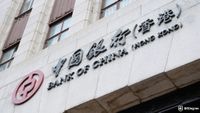Federal Reserve claims stablecoins could bring financial instability to the US economy.
The Federal Reserve Banks of Boston and New York have recently issued a staff report that underscores the similarities between stablecoins and money market funds.
The report, released on September 26th, draws parallels between the behaviors of stablecoin and money market fund investors, particularly during periods of market stress.

Did you know?
Want to get smarter & wealthier with crypto?
Subscribe - We publish new crypto explainer videos every week!
What is DeFi in Crypto? (Explained with Animations)


According to the Federal Reserve's study, stablecoins, like Tether (USDT) and USD Coin (USDC), exhibit similar characteristics to money market funds, especially during "runs" or periods of financial instability.
The researchers found that these runs could threaten the broader financial landscape, indicating that the widespread adoption of stablecoins could bring about economic instability.
Our findings show that stablecoins are vulnerable to runs during periods of broad crypto market dislocation as well as idiosyncratic stress events. Should stablecoins continue to grow and become more interconnected with key financial markets <...>, they could become a source of financial instability for the broader financial system.
One pivotal observation from the report is the notion of a "break-the-buck" threshold for stablecoins. This threshold refers to a stablecoin's value dropping below $0.99, at which investor redemptions increase significantly. This concept is akin to a similar phenomenon in money market funds, where a drop in net asset value below one dollar causes a rush of redemptions.
A recent report by S&P Global analysts indicates that among top stablecoins, USD Coin and Dai (DAI) have exhibited a higher tendency to lose their dollar peg. On the other hand, Tether and Binance USD (BUSD) showed considerable resistance to market fluctuations.
As stablecoins continue gaining traction, the financial system's potential risks are becoming more apparent. The Federal Reserve's recent report serves as a timely warning, urging policymakers and industry stakeholders to consider these risks. Both domestic and international entities are increasingly echoing these sentiments, reinforcing the need for coordinated regulatory action.






















